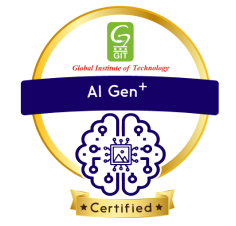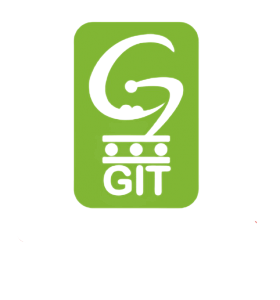
Multimodal Generative AI: Creating and Deploying Diverse Content
Are you ready to embark on a transformative journey into the world of Artificial Intelligence (AI)?
NEXT STARTS
Enrollment is ongoing. Join today—spots are filling fast!
PROGRAM DURATION
80 Hours
LEARNING FORMAT
Online Bootcamp
Course Description
The Global Institute of Technology ‘Multimodal Generative AI ‘ is a Certification program designed to prepare learners for entry to mid-level employment opportunities in the field of Artificial Intelligence. Throughout this program, students will Discover the world of Generative AI and its pivotal role in modern technology. Master the fundamentals of neural networks, enabling you to create diverse content across modalities. Learn to generate text using cutting-edge Large Language Models and explore the fascinating scenarios of style transfer and image-to- image translation. Unleash your creativity by using Generative AI to create art and music.
Gain expertise in code generation, a vital skill in today’s AI landscape. Bridge different modalities through cross-modal generation and deploy your multimodal Generative AI solutions effectively. Navigate the ethical considerations and responsibilities of AI technology, ensuring responsible and transparent use. Finally, apply your knowledge in real-world scenarios through final projects and presentations. Join us on this transformative journey into the world of Generative AI and multimodal content generation.
Course Objectives
Upon completing this course on Multimodal Generative AI, students will achieve the following objectives:
- Understand Generative AI and Its Significance
- Master Neural Network Fundamentals
- Generate Text Using Large Language Models
- Explore Style Transfer and Image-to-Image Translation
- Create Art and Music Using Generative AI
- Master Code Generation
- Bridge Modalities with Cross-Modal Generation
- Deploy Multimodal Generative AI Solutions
- Address Ethical Considerations and Responsible AI
Complete Final Projects and Presentations By achieving these objectives, students will acquire comprehensive knowledge and practical skills in Generative AI and Multimodal Content Generation, enabling them to contribute effectively to this rapidly evolving field while considering ethical implications and responsible AI practices.

Prerequisites
Basic understanding of machine learning concepts. Familiarity with neural networks is a plus.
Course Duration
80 Hours (40 Hours Instructor-led live training and 40 Hours Instructor Guided)
Prerequisites
Basic understanding of machine learning concepts. Familiarity with neural networks is a plus.
Course Duration
80 Hours (40 Hours Instructor-led live training and 40 Hours Instructor Guided)
Course Contents
1. Session 1-2: Introduction to Generative AI and Multimodal Content (4 hours)
- Overview of Generative AI and its significance across modalities. Generative AI extension of traditional Machine and Deep Learning Introduction to generating diverse content: text, images, art, and music. Generating the content using the tools
available in the marketplace - Generative AI applications and use cases
2. Session 3-4: Fundamentals of Neural Networks for Multimodal Generation (6 hours)
- Review of neural network basics for different modalities.
- Environment setup: Installing Python, TensorFlow, and other libraries as well Amruta Inc and other containers for no code/low code configuration.
- Architectures and their applications, including Variational Autoencoders (VAEs), Generative Adversarial Networks (GANs), Autoregressive generative models/Recurrent Neural Networks (RNNs), and Transformers
- Generative AI Tools, such as ChatGPT, BARD, Llama, Codex Dall.E, Synthesia, Designs.ai, Replica, AIVA …
3. Session 5-6: Generating Text with Large Language Models (6 hours)
- Text generation using Large Language Models (LLMs): Concepts and applications. Improving LLM performance using Prompt engineering, fine tuning, Retrieval Augmented Generation (RAG), and other techniques
- Hands-on: Using LLMs for text completion and generation. LangChain
- Identifying Risks in Text Generation
1. Discussion: What can go wrong?
2. Bias in LLMs – Examples and origins of bias (in training data)
3. Misinformation & Fake content generation (hallucinations)
4. Context misunderstanding & Ambiguities
5. Loss of confidential data (through prompt inputs)
6. Unethical use such as harmful/inappropriate content generation and malware generation
7. Cyber fraud (fake reviews) and attacks (prompt injection)
8. Copyright violations
9. Unfair and deceptive practices including regulatory non-compliance (e.g., California chatbot law).
4. Session 7-8: Style Transfer and Image-to-Image Translation (2 hours)
- Neural style transfer and image-to-image translation concepts.
- Hands-on: Implementing style transfer and image-to-image translation.
5. Session 9-10: Creative Art and Music Generation (2 hours)
- Applications of Generative AI in art and music.
- Hands-on: Generating art and music using GANs and RNNs, and the tools available in the marketplace
6. Session 11-12: Code Generation (3 hours)
- Code Generation: Concepts and applications.
- Hands-on: Creating and testing code.
7. Session 13-14: Cross-Modal Generation (1 hour)
- Cross-modal generation: Text-to-image, image-to-music, etc.
- Hands-on: Generating content that bridges modalities.
8. Session 15-16: Deploying Multimodal Generative AI Solutions (2 hours)
- Deployment strategies and considerations for diverse content generation.
- Practical: Deploying models for different modalities.
9. Session 17-18: Ethical Considerations and Responsible AI (6 hours)
- Ethical challenges in multimodal content generation.
- Responsible AI principles and mitigation strategies.
- Mitigating Risks in Text Generation
o Safeguard mechanisms
1. Pre-set content filters
2. Limiting certain topics or trigger words
o Real-time monitoring and human-in-the-loop
1. Incorporating human oversight during text generation
2. Quantifying the business and citizen value
o Methods for model improvement
1. Encouraging users to report inappropriate outputs
2. Iterative model retraining with cleaner data
3. Customization of LLMs with information retrieval and other methods
o Ethical considerations & transparency
1. Ensuring stakeholders understand the source and limitations of the text.
10. Session 19-20: Final Projects and Presentations (8 hours)
- Students work on multimodal generative AI projects with deployment.
- Project presentations and discussions on deployment challenges.
Assessment:
- Regular quizzes, assignments, and hands-on projects.
- Evaluating the final projects and deployment strategies.
- Ethical reflection and responsible AI considerations in projects.
Note:
This curriculum offers a comprehensive exploration of multimodal content generation, covering text, images, art, and music. It emphasizes both the technical aspects and the creative potential of generative AI across different modalities. Depending on the interests and backgrounds of your students, we can adjust the focus and complexity of each modality.
Your AI journey begins here. Join us at Git Services, and let’s explore the limitless possibilities of Artificial Intelligence together.
Resources
- Books: XXX “Artificial Intelligence: A Modern Approach” by Stuart Russell and Peter Norvig; “Deep Learning” by Ian Goodfellow, Yoshua Bengio, and Aaron Courville.
2. Tools: XXX-Amruta Inc AI/ML/explainable AI software.
